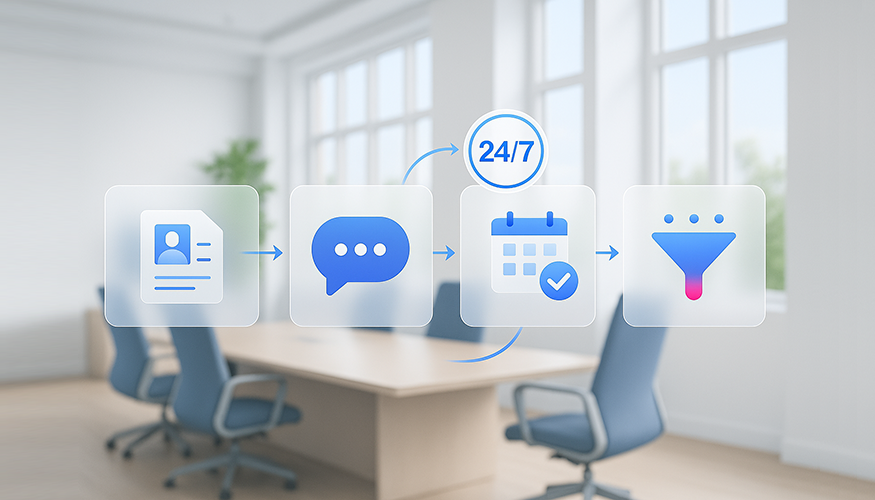Table of Contents
- Appointment scheduling⪢
- After-service follow-up ⪢
- Review management ⪢
- Status updates ⪢
- Checkout ⪢
- Why CSI matters (and what “good” looks like)
- The 5-stage automation framework to Increase CSI scores
- Playbooks
- Manual vs Automated CSI programs (at a glance)
- Best practices to Improve CSI scores (and keep them)
- CSAT vs CSI vs NPS (quick guide)
- What to measure on your Dashboard / one platform
- Missed calls recovered by voice AI or conversational AI
- Approval time after video MPI
- Payment completion via text-to-pay/digital payments
- Survey response rates (CSI/CSAT/NPS)
- Review volume and ratings from Manage online reviews
- Parts availability delays and their impact on CSI
- Fix-it-right-the-first-time rate and comeback ratio
- Put it all together with Whippy
- FAQ (snippet-ready)
- Final thought
Try Whippy for Your Team
Experience how fast, automated communication drives growth.

Improving or increasing Customer Satisfaction Index (CSI) scores starts with looking at the full customer journey—not just one interaction. Every touchpoint matters, from how you handle phone calls to how you manage digital communication and in-person service.
The fastest way to make measurable gains is through automation. By streamlining key moments like scheduling, updates, checkout, and follow-up, dealerships and service centers can reduce friction, deliver timely communication, and meet what customers expect in today’s market.
In this article, we’ll break down the five moments that matter most and show you how Automations—from sms texting to voice AI—can help you boost customer satisfaction, build loyalty, and hit the 2025 J.D. Power U.S. Customer Service Index (CSI) Study factors that drive OEM incentives.
Let’s dive into the 5-stage automation framework that makes it possible:
Appointment scheduling⪢
When customers can book instantly via sms texting, webchat, or a quick return call through call routing/VoIP, you eliminate friction. Adding a voice AI system to capture missed calls ensures you never lose a lead.
After-service follow-up ⪢
Automated customer feedback via One-tap surveys or CSI surveys gives you fresh insights into how customers feel right after pickup. These are perfect for measuring customer satisfaction before the official OEM survey arrives.
Review management ⪢
Using automation to Manage online reviews ensures happy customers share their stories online, while you address negative feedback privately—supporting long-term reputation management and Online reputation.
Status updates ⪢
Providing proactive communication and Real-time feedback reduces anxiety and boosts customer centricity. When people know exactly what’s happening, they’re less likely to churn and more likely to rate the experience positively.
Checkout ⪢
With digital payments and text-to-pay, checkout becomes fast and stress-free, reducing the customer effort score (CES) and strengthening perceptions of your quality (service/product), as well as your products and services.
This combination of automations boosts customer experience (CX), communication clarity, timely communication, and overall convenience. These are the very J.D. Power CSI factors that drive OEM recognition, OEM bonuses/perks, and OEM incentives. The result? Improving customer satisfaction, stronger retention and loyalty, and a Good CSI score that translates into growth.
Why CSI matters (and what “good” looks like)
CSI (Customer Satisfaction Index) isn’t just a benchmark—it’s a measure of how well your dealership or service department delivers on customer centricity and expectations across both sales and fixed ops.
A Good CSI score impacts your business in four key ways:
- OEM incentives & bonuses: High CSI unlocks rewards and protects vehicle allocation.
- Customer loyalty: Strong scores make existing customers more likely to return, fueling retention and referrals.
- Employee satisfaction: When team members have clear processes and fewer complaints, they provide better service quality.
- Reputation: CSI drives online reviews, word-of-mouth, and overall Online reputation.
According to the J.D. Power CSI study, top-performing dealerships consistently:
- Reduce wait times with efficient scheduling.
- Maintain transparency with pricing and repairs.
- Deliver fix-it-right-the-first-time service.
- Keep customers informed with timely communication.
And while CSI is crucial, don’t measure in isolation. Combine it with Net Promoter Score (NPS) and Customer Effort Score (CES) to get a complete picture of satisfaction and loyalty.
👉 The goal: increase satisfaction by pairing well-trained people with the right automation tools to create a consistently strong overall customer experience.
The 5-stage automation framework to Increase CSI scores
Improving CSI scores requires a structured approach. Here’s a breakdown of how to apply automation at each stage:
1) Before the visit: set expectations and capture demand
Appointment scheduling via mobile friendly links in sms texting, webchat, or telephone/VoIP system gives customers convenience right away.
Route phone calls with call routing/VoIP, and use call tracking to ensure no inquiry gets lost—critical for converting existing customers and new prospects.
Share service facility/amenities, parking, and parts availability details early through proactive communication.
Personalize with options like courtesy rides or loaner vehicles, reinforcing customer centricity.
If a call is missed, voice AI or conversational AI can text back instantly, reschedule, and ensure customers feel heard. This reduces no-shows, lowers CES, and improves efficiency for your team members.
2) During the repair: remove uncertainty with digital communication
Provide status updates via sms texting or webchat with Real-time feedback loops.
Attach video messaging or a video MPI (multi-point inspection) to demonstrate transparency and improve perceptions of service quality.
Allow instant approval for work through digital messages with transparent pricing—making the process clear and low-effort.
Keep service advisor communication consistent and empathetic. Advisors who use automation for timely communication have more bandwidth for building real relationships, while automation handles repetitive updates.
This stage is key to improving customer satisfaction and directly aligns with J.D. Power CSI factors like communication, transparency, and efficiency.
3) Checkout: make it effortless
Provide digital payments and text-to-pay for speed and convenience.
Confirm vehicle pickup experience details—location, hours, and any special instructions—via Instant alerts.
Sync updates with DMS and CRM integration so service notes, payment records, and customer interactions flow seamlessly across systems. This ensures the service department, sales, and fixed ops teams share the same customer history, reducing errors and reinforcing communication clarity.
Automation here reduces the customer effort score (CES) while increasing customer satisfaction by making checkout nearly frictionless.
4) After-service follow-up: close the loop
Trigger Post-service surveys, CSI surveys, or One-tap surveys to Automate CSI surveys and gather Automated customer feedback.
Open Feedback collection workflows immediately if issues arise, giving your team members a chance to resolve problems before the official OEM survey.
Use Manage online reviews tools to guide satisfied customers toward online reviews, improving reputation management and Online reputation.
By acting quickly with follow-up automation, you protect both your CSI score and your OEM incentives.
5) Ongoing retention: turn satisfaction into loyalty
Launch automations and structured campaigns for maintenance reminders, seasonal checkups, or targeted service specials. These proactive touches not only improve/increase CSI but also keep your dealership top of mind between visits, building brand loyalty over time.
Segment metrics inside a Dashboard / one platform with analytics/monitoring. Look at advisor performance, CSI movement, and even how parts availability delays impact satisfaction.
Align results with J.D. Power CSI factors and your j.d. power csi study focus areas to ensure you’re competing at the top level.
This stage ensures retention and loyalty while also fueling sales experience improvements, better customer centricity, and opportunities to capture more word-of-mouth/referrals.
Playbooks
Automation becomes most powerful when applied as step-by-step playbooks inside an automotive dealership or service department. By designing clear workflows, team members know exactly how to react when triggers happen, while the system handles the repetitive work. Below are five detailed playbooks that combine automations, voice AI, conversational AI, and smart workflows to reduce the customer effort score (CES), improve efficiency, and ultimately boost customer satisfaction and CSI scores across the entire automotive industry.
Playbook A — Missed-call rescue (sales & service)
Trigger: An inbound call goes unanswered.
Automation: Call routing/VoIP retries multiple team members. If still missed, voice AI or conversational AI sends an sms texting follow-up: “Sorry we missed your call. Want to schedule now?”
Outcome: Saves missed calls, lowers customer effort score (CES), and ensures personalized interactions. Protects J.D. Power CSI factors like convenience and communication clarity, which boost OEM incentives.
Playbook B — In-service status + approvals
Trigger: A repair order (RO) is opened or updated.
Automation: Send Timely communication with ETA, attach a video MPI (multi-point inspection) for transparency, and include transparent pricing for instant digital approvals.
Outcome: Reduces “Where’s my car?” phone calls, builds trust, and increases satisfaction. Advisors save time, efficiency rises, and both CSI scores and Net Promoter Score (NPS) improve.
Playbook C — Checkout + pickup
Trigger: Work is marked complete.
Automation: Share a text-to-pay link, confirm vehicle pickup experience details with Instant alerts, and offer courtesy rides if needed.
Outcome: Shorter wait times, smoother checkout, and higher service quality perception. Customers leave happier, fueling brand loyalty and higher CSI scores.
Playbook D — After-service follow-up and CSI/NPS
Trigger: 2–24 hours after pickup.
Automation: Send One-tap surveys (CSI/CSAT/NPS). Route Real-time feedback to the right team members with Instant alerts for quick recovery.
Outcome: Issues are solved before the OEM survey hits. This boosts customer satisfaction, improves retention, and protects OEM bonuses/perks.
Playbook E — Review + referral flywheel
Trigger: A positive survey or high NPS score.
Automation: Request an online review, invite referrals, and schedule a maintenance reminder tailored to the customer’s products and services.
Outcome: Builds Online reputation, drives word-of-mouth/referrals, and strengthens long-term overall customer experience—all powered by automations that reduce workload.
Manual vs Automated CSI programs (at a glance)
Many dealerships still rely on manual processes that frustrate both customers and staff. Here’s how those compare with automated programs designed to boost customer satisfaction and increase efficiency:
Dimension | Manual program | Automated, digital communication program |
|---|---|---|
Scheduling | Phone tag; higher wait times | Self-serve appointment scheduling; call routing/VoIP recovers calls |
In-service updates | Ad-hoc phone calls | Predictable SMS/web updates + video messaging/video MPI |
Approvals & pricing | Paper, desk visits | Mobile approvals with transparent pricing |
Payment & pickup | Counter lines | text-to-pay, fast vehicle pickup experience |
Feedback & reviews | Low response | Automate CSI surveys, Automated customer feedback, smart review management |
Insights | Spreadsheets | Unified Dashboard / one platform with analytics/monitoring |
By shifting to automation, dealerships reduce customer effort, allow team members to focus on high-value personalized interactions, and ensure consistency across every customer journey.
Best practices to Improve CSI scores (and keep them)
1. Communicate early and often. Proactive, Timely communication reduces anxiety and improves CES. Customers feel valued when they receive updates instead of having to chase the dealership with phone calls.
2. Make it visual. Video MPI and photos build trust in service quality and transparency. Visuals help customers understand what’s happening with their vehicle and lower perceived effort.
3. Eliminate friction. Digital payments, clear vehicle pickup experience instructions, and options like loaner vehicles and courtesy rides create convenience and increase satisfaction.
4. Standardize advisor handoffs. Clear scripting and training for service advisor communication reduce confusion, maintain standards, and deliver consistent value to every existing customer.
5. Instrument everything. Track metrics like response times, approval rates, and CSI by advisor/RO with analytics/monitoring. Use insights to coach team members and boost customer loyalty.
6. Integrate systems. Ensure dms integration so fixed ops, parts department, and surveys sync seamlessly, reducing administrative errors.
7. Protect customer data. Whippy is SOC 2 Type 2 compliant, so every interaction—surveys, payments, and communications—is handled with security and compliance at the highest standards. This builds trust while you improve CSI scores.
8. Close the loop. A fast follow up/follow-up after pickup shows care and helps resolve small issues before they escalate. This protects your OEM incentives and helps sustain long-term retention and loyalty.
CSAT vs CSI vs NPS (quick guide)
Understanding the differences between these measurements is essential for any automotive dealership focused on measuring customer satisfaction and practicing customer centricity:
- CSAT= “How satisfied were you with this interaction?” → Best for single touchpoints, and a leading indicator of immediate satisfaction.
- CSI (Customer Satisfaction Index)= A brand or dealership-level score that reflects overall service experience and sales process quality. CSI is the measure most tied to OEM incentives and J.D. Power CSI factors.
- Net Promoter Score (NPS)= “Would you recommend us to a friend?” → Strong predictor of loyalty, word-of-mouth/referrals, and Online reputation.
📌 Pro tip: Use all three together. CSI scores show brand alignment, CSAT captures transactional performance, and NPS reveals long-term loyalty. Together, they guide team members on where to improve and help the dealership deliver consistent, personalized interactions that increase satisfaction across the board.
What to measure on your Dashboard / one platform
A dealership can only improve CSI scores if it has clear visibility into key metrics. A Dashboard / one platform centralizes the numbers that matter most, allowing managers to see the direct link between automations, customer journeys, and actual CSI scores. These insights are not just numbers—they represent the overall customer experience, and they show where your dealership is building brand loyalty or where it might be falling short.
Here’s what you should be measuring:
Missed calls recovered by voice AI or conversational AI
Every unanswered call is a lost opportunity. When you track how many missed calls are automatically saved by voice AI, you understand how automation protects both sales and service. This is one of the fastest ways to reduce frustration and improving customer satisfaction, because customers expect prompt answers when they reach out by phone calls.
Approval time after video MPI
Using video messaging or a video MPI (multi-point inspection) builds trust by showing the real condition of a vehicle. Measuring how quickly an existing customer approves work after seeing a video is a direct reflection of transparency, personalization, and service quality. Faster approvals mean better efficiency, reduced downtime, and an improved CSI score.
Payment completion via text-to-pay/digital payments
Customers value convenience, especially when it comes to payments. Tracking how quickly customers complete bills via text-to-pay or digital payments shows whether your checkout process reduces effort and meets modern expectations for mobile experiences. Faster completion means lower wait times and higher satisfaction.
Survey response rates (CSI/CSAT/NPS)
Measuring customer satisfaction requires more than one survey. Monitor response rates for CSI surveys, sms surveys, One-tap surveys, and overall completion rates for CSAT and net promoter score (NPS). High response rates reveal that your customers feel engaged and heard, while follow-up with detractors helps you resolve problems before they hit official OEM surveys.
Review volume and ratings from Manage online reviews
Your Online reputation is shaped by online reviews. Tracking the number of reviews, average rating, and how many come directly from Automated customer feedback requests helps you understand whether your reputation management efforts are effective. Each online review represents real feedback and affects both perception and measurement of the overall customer experience.
Parts availability delays and their impact on CSI
When the parts department struggles with parts availability, it often creates longer wait times. This directly affects CSI scores, because customers judge the dealership on service facility/amenities, service department responsiveness, and value. Monitoring this metric helps you identify bottlenecks in your products and services that hurt increasing customer satisfaction.
Fix-it-right-the-first-time rate and comeback ratio
The fix-it-right-the-first-time standard is a cornerstone of J.D. Power CSI factors and the j.d. power csi study. Tracking how often a repair is completed correctly the first time directly ties into service quality, communication clarity, and standards. When comebacks go down, satisfaction and brand loyalty go up.
By tying each measurement back to J.D. Power CSI factors, you ensure that your improvements are not just internal wins but also aligned with what OEMs actually evaluate. This helps secure OEM incentives, maintain vehicle allocation, and prove that your dealership delivers true customer centricity.
Put it all together with Whippy
Whippy is built for dealerships and service businesses that want to modernize how they communicate and serve customers. Instead of juggling disconnected tools, Whippy unifies sms texting, webchat, telephone/VoIP systems, voice AI, conversational AI, review management, and analytics/monitoring into a single Dashboard / one platform.
Here’s why it matters:
- Your team can handle more customers without burning out, because automation helps reduce workload.
- Every existing customer interaction—whether through phone calls, sms surveys, or after-service follow-up—feels more like a personalized interaction and less like a generic transaction.
- Team members can focus on empathy, coaching, and staff training, while the platform handles reminders, follow-up, and survey delivery.
- You gain real value from streamlined workflows that cut down wait times, increase convenience, and improve the overall customer experience.
Whippy is not just about sending texts. It’s about measuring customer satisfaction, aligning with CSI scores, and helping dealerships hit key metrics that support increasing customer satisfaction, brand loyalty, and OEM incentives.
FAQ (snippet-ready)
Q: What is the fastest way to improve CSI scores?
A: The fastest way to improve CSI scores is to use automation. Automate appointment scheduling, send Real-time feedback updates during service, offer text-to-pay, and trigger Post-service surveys or Automate CSI surveys with Instant alerts. This lowers customer effort score (CES), keeps customers expect in mind, and ensures issues are solved before OEM surveys arrive.
Q: What counts as a Good CSI score?
A: A Good CSI score varies by brand and market. The best approach is to aim higher than your OEM’s benchmarks (e.g., J.D. Power) and continually improve internal standards like transparency, service quality, and fix-it-right-the-first-time. Strong scores unlock OEM incentives, OEM bonuses/perks, and better vehicle allocation.
Q: Which tools have the biggest impact on Dealership CSI?
A: Tools that matter most include call routing/VoIP with call tracking to recover missed calls, voice AI/conversational AI for 24/7 coverage, video MPI and video messaging for transparency, sms texting, webchat, digital payments, text-to-pay, and unified analytics/monitoring. These help streamline communication clarity and improve the overall customer experience.
Q: How do automations affect retention and loyalty?
A: Automations reduce wait times, deliver Timely communication, and provide personalized interactions with minimal effort. By addressing pain points quickly and offering convenience, they increase satisfaction, build brand loyalty, and encourage word-of-mouth/referrals. This directly supports long-term customer retention and better Online reputation through online reviews.
Final thought
Improving CSI doesn’t have to be difficult—it comes down to following a clear process. With the right mix of automation, streamlined workflows, and a well-trained team, your dealership can deliver consistent, high-quality experiences that customers trust. By tracking the right metrics and focusing on customer satisfaction at every step, you build loyalty, strengthen your reputation, and naturally raise your CSI scores.
The true benefit isn’t just a higher CSI—it’s creating a smoother, more predictable customer experience. When that happens, strong scores will follow.
🚀 Ready to see how automation can transform your CSI program?
Request a Whippy demo today and discover how easy it is to boost customer satisfaction, protect OEM incentives, and unlock new growth.
Table of Contents
Table of Contents
- Appointment scheduling⪢
- After-service follow-up ⪢
- Review management ⪢
- Status updates ⪢
- Checkout ⪢
- Why CSI matters (and what “good” looks like)
- The 5-stage automation framework to Increase CSI scores
- Playbooks
- Manual vs Automated CSI programs (at a glance)
- Best practices to Improve CSI scores (and keep them)
- CSAT vs CSI vs NPS (quick guide)
- What to measure on your Dashboard / one platform
- Missed calls recovered by voice AI or conversational AI
- Approval time after video MPI
- Payment completion via text-to-pay/digital payments
- Survey response rates (CSI/CSAT/NPS)
- Review volume and ratings from Manage online reviews
- Parts availability delays and their impact on CSI
- Fix-it-right-the-first-time rate and comeback ratio
- Put it all together with Whippy
- FAQ (snippet-ready)
- Final thought
Try Whippy for Your Team
Experience how fast, automated communication drives growth.
Related Articles

AI Automation for Logistics Companies: Faster CX

Best AI Sales Tools to Close More Deals

After Hours Recruiting: Convert Applicants 24/7

Phone Number Porting vs Hosting: Complete Business Guide

Best AI Resume Screening Software to Shortlist Faster
